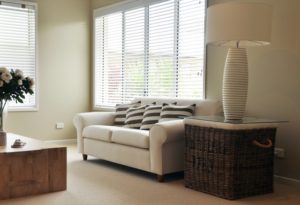Creating a Healthy Interior

Since most of us spend an average of 90 percent of our time indoors, it’s important to create a healthy environment in which to live. While we may not have enough control or influence over our work environment, we can certainly make healthier decisions about our homes.
Many newer homes are built much “tighter” than usual so that they are more energy efficient. This means they are well-sealed to minimize leaks that lets heat escape in the winter, or intrude in the summer. On the other hand, older homes have the equivalent of a small window open at all times, given all the leaks around doors, windows, vents and other penetrations to the building envelope.
This air exchange is important to maintain fresh air, and a qualified energy auditor can tell you how tight your home is. If your home is very tight, you should consider installing a ventilation system designed to eliminate the transfer of heat. Energy Recovery Ventilators are becoming a standard add-on in new homes. It’s also important to have natural ventilation systems when the weather permits, including attic exhaust fans and operable windows or skylights. However, it’s an even better idea to minimize the pollutants to begin with.
We should all be aware of the dangers of asbestos, formaldehyde, lead, mold, carbon monoxide and radon, but many common household substances emit harmful pollutants, too. Volatile Organic Compounds (VOCs) are everywhere, and while there is still some debate about the impact on human health, they have been linked to a number of health issues, including cancer, asthma and other respiratory problems. VOCs can be emitted from either liquids or solids and are found in paints and lacquers, solvents and adhesives, pesticides, aerosols, inks, cosmetics, and cleaning supplies. Many air “fresheners,” for example, contain toxic or hazardous substances!
It seems like a no-brainer to suggest that you minimize the use of poisons. If you look under your kitchen sink, though, you’re likely to find a lot of toxic substances. There are plenty of natural cleaners available at local supermarkets, but other products like St. Louis-based Herb’n Maid can be purchased at specialty shops. You can also find eco-friendly pest control solutions. Rottler Pest Control’s line of environmentally safe products earned the company a distinctive industry certification. Natural pesticides have fewer harmful side effects and break down more quickly in the environment than synthetic chemicals do. Keep in mind that they’re still poisons and harmful to humans, so use non-chemical methods of pest control whenever possible. If the label says “use in well-ventilated area” you might want to reconsider whether you want to use it at all.
Then there’s paint. Just like that “new car scent,” we’ve been conditioned to believe that the smell of fresh paint is a good thing. In fact, that odor is the barrage of airborne chemicals released from the paint as it dries. Oil-based paints are the worst, containing volatile solvents that are hazardous to handle and unhealthy to breathe. Water-based latex paints generally contain a lower level of VOCs, but these aren’t much more environmentally-friendly. In their quest to deliver convenience, paint manufacturers have developed paint mixtures that dry faster. The solvents in the paint, which keep the paint in a liquid form in the can, are designed to evaporate quickly, which results in higher levels of VOCs. The best choice is to look for low- or no-VOC paints, which can now be found at most paint stores. Products that carry the Green Seal logo are best, as they not only have low levels of VOCs, but also refrain from using a long list of toxic chemical compounds. A great resource is The Learning Channel’s How Stuff Works.
The last area to consider is your flooring. From a sustainability standpoint, it’s best to purchase flooring finishes made with renewable materials, like bamboo, cork and linoleum, or hardwood floors from a certified sustainable forest. If you plan to install carpet, there are a number of eco-friendly options to consider. Mohawk Flooring developed a carpet fiber made from recycled plastic bottles, and has recycled over 24 billion plastic bottles since 1999. You can also purchase carpet made from corn, which requires no petroleum products and is biodegradable. Perhaps the best option is Shaw’s “cradle-to-cradle” approach, where they recycle their own carpet back into new carpet.
These examples are just a few of the many ways you can create a healthy interior. For more ideas, information and strategies to improve the indoor air quality in your home, check out the EPA’s website. With each new project you complete in your home, you’ll improve your health and quality of life.
This was published in the Going Green section of the June 2010 issue of Spirit Seeker magazine.

0 Comments